The error message “The following remoteapp is not in the list of authorized” can arise due to various factors, ranging from misconfigurations to security concerns. This comprehensive guide delves into the potential causes of this issue and provides a structured approach to resolving authorization problems, ensuring seamless access to remote applications.
Understanding the underlying mechanisms of RemoteApp authorization is crucial for effective troubleshooting. This guide explores the configuration process, security implications, and common troubleshooting techniques, empowering users to diagnose and rectify authorization errors swiftly and efficiently.
RemoteApp Authorization Issues

The error message “the following remoteapp is not in the list of authorized” occurs when a user attempts to access a RemoteApp that has not been properly authorized.
Potential causes include:
- The RemoteApp has not been added to the list of authorized RemoteApps on the Remote Desktop Gateway (RD Gateway) server.
- The user does not have the necessary permissions to access the RemoteApp.
- The RemoteApp is not published correctly on the RD Gateway server.
To resolve authorization issues, follow these steps:
- Ensure that the RemoteApp has been added to the list of authorized RemoteApps on the RD Gateway server.
- Verify that the user has the necessary permissions to access the RemoteApp.
- Check that the RemoteApp is published correctly on the RD Gateway server.
RemoteApp Configuration: The Following Remoteapp Is Not In The List Of Authorized

To add a RemoteApp to the authorized list, follow these steps:
- Open the RD Gateway Manager console.
- Click on the “RemoteApps” tab.
- Click on the “Add” button.
- Enter the name of the RemoteApp and the path to the executable file.
- Click on the “OK” button.
The following table compares the configuration options for different RemoteApp scenarios:
| Scenario | Configuration |
|---|---|
| Single RemoteApp | Add the RemoteApp to the list of authorized RemoteApps on the RD Gateway server. |
| Multiple RemoteApps | Create a RemoteApp collection and add the RemoteApps to the collection. |
| RemoteApp with parameters | Specify the parameters in the “Command line arguments” field when adding the RemoteApp to the list of authorized RemoteApps. |
Security Considerations

Authorizing RemoteApps has security implications, including:
- Increased attack surface: RemoteApps expose additional attack vectors for malicious actors.
- Data leakage: RemoteApps can be used to exfiltrate sensitive data from the network.
- Malware distribution: RemoteApps can be used to distribute malware throughout the network.
- Implement strong authentication mechanisms.
- Use network segmentation to isolate RemoteApp servers from the rest of the network.
- Monitor RemoteApp activity for suspicious behavior.
- Verifying that the RemoteApp is published correctly on the RD Gateway server.
- Checking that the user has the necessary permissions to access the RemoteApp.
- Ensuring that the RD Gateway server is configured correctly.
To secure RemoteApp environments, follow these best practices:
Troubleshooting Techniques

Common troubleshooting methods for resolving RemoteApp authorization errors include:
The following table lists common error codes and their corresponding solutions:
| Error Code | Solution |
|---|---|
| 0x80070005 | Access denied. Verify that the user has the necessary permissions to access the RemoteApp. |
| 0x80070003 | The system cannot find the path specified. Verify that the path to the RemoteApp executable file is correct. |
| 0x8007006D | The remote procedure call failed. Verify that the RD Gateway server is configured correctly. |
FAQs
What are the common causes of the “The following remoteapp is not in the list of authorized” error?
Misconfigurations in RemoteApp settings, incorrect user permissions, or security restrictions can trigger this error.
How can I troubleshoot RemoteApp authorization issues?
Verify RemoteApp configuration, check user permissions, and review security settings to identify and resolve authorization problems.
What are the security implications of authorizing RemoteApps?
Authorizing RemoteApps introduces potential security risks, such as unauthorized access to sensitive data or malware infiltration. Implementing strong security measures is essential to mitigate these risks.